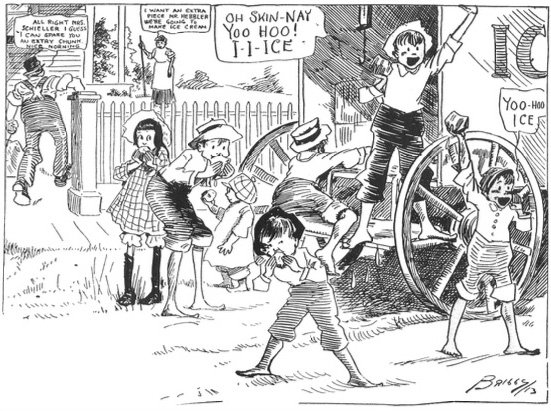This weekend’s weather reminded us that ice harvesting was big business before refrigeration and local ice houses would have welcomed those freezing temperatures.
From the time of the early settlers on Cape Cod, on up to the nineteen-fifties, ice was harvested from lakes and ponds. In the seventeenth century locals would head to the nearest fresh water source, and by whatever means possible, usually with just an axe, chop what they needed.
Over time methods and tools were developed to maximize the harvest, allowing ice to become a commercial commodity. In order to have ice available past the coldest months, ice houses were built for storage and preservation. They were constructed with double walls insulated by salt hay, sea weed, sawdust or pine needles. The roofs were often painted white to reflect the heat of the sun. The floor was covered in sand and the ice stacked with sawdust between each layer for insulation and ease of separation. Dampness being the enemy of ice, they were built in the open, away from trees and greenery.
Usher’s Ice House at the west end of Dennis Pond
By the mid-nineteenth century almost every town and village had at least one commercial harvesting operation and those without regular jobs were happy for the extra work in winter. Yarmouth was no exception, and in fact had several at the same time. They were located at Dennis Pond, Sandy Pond, Whites Brook, Mathews Pond, James Pond and Long Pond. With over three hundred and fifty lakes and ponds on Cape Cod, there was no shortage of the resource during the cold winter months.
One common method of ice cutting was the use of a horse pulled, plow-like combination saw blade and guide. A straight line was marked on the ice and a groove was cut into the line. The guide was placed in the groove and the parallel saw blade cut the blocks. This allowed the “cakes,” to be cut to equal size. After several passes the cuts got deeper leaving less ice for the final cut by hand saws. Many of the tools used for this operation resembled those used by loggers, such as long saws for cutting, thongs and pikes to lift the blocks and slide them to the ice house.
Ice harvesting on Sandy Pond in West Yarmouth.
Ice harvesting was not without dangers; it was not uncommon for man or beast to fall into the frigid water. They had to be pulled out and dried off quickly to prevent hypothermia. It took keen senses and experience to know how much to cut while keeping the ice sheet safe. Sam Thacher recalled falling in and running all the way home from Dennis Pond to near the Yarmouth Port Playground before he froze, to get dry clothes.
A horse and wagon, a man with a strong back, and a few basic tools were all that was required to deliver ice. The ice man’s tool kit comprised of an ice pick, scraper, tongs and a shoulder pad. Delivering ice was hard work, especially in an urban setting due to the stairs and the number of customers in each multi-level dwelling. The iceman’s day started in the pre-dawn hours and ended twelve-to-fourteen hours later.
Usher’s Dennis Pond Ice in Yarmouth Port
As small towns and urban centers grew, it was not easy for the iceman to memorize each customer and what their needs were. As with most things when technology had not yet invaded our lives, a simple solution was put in place. A card that indicated how much ice was needed was displayed in a window facing the street. The card had amounts printed on its four sides, simply by turning the card so that the desired amount was at the top, the iceman was able to cut what the customer needed. This method was also used for coal, and later for oil deliveries.
Example of an ice delivery card.
The Bay State Freezer Company, started in 1916, was located in Yarmouth Port on Wharf Lane. It was a large commercial ice making business that catered mostly to the fishing industry. They owned a dock that enabled the fishing boats to load directly from the plant. They also offered storage facilities to keep the catch fresh prior to distribution. The development of frozen foods and on-board vessel ice making led to the operation closing in 1921.
Bay State Freezer Company in 1919, located at 111 Wharf Lane, Yarmouth Port
Fast forward to current times, ice is at our fingertips. No longer do we need to scrape or chip ice, it’s readily available in convenient cubes. Need some for a quick drink, it’s on the refrigerator door. Need some for a pitcher full, it’s in the freezer in refillable trays. Need some for a party, there’s a big chest full of bagged ice cubes out in front of the nearest grocery store or gas station.
The memory of ice harvests, the joy of a chunk of ice on a hot summer day, and the old kitchen ice box, lingers among the cobwebs in the minds of those of us of who are of a certain age. With age comes the knowledge that there’s more to life than convenience.
Kids grabbing ice chunks on a hot summer day - considered a real treat.
excerpted from an article by Frank Tardo







